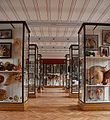Fragonard Museum
The Musée Fragonard in Maisons-Alfort near Paris is a medical history museum with a historicizing exhibition concept from around 1900. It is part of the veterinary university École nationale vétérinaire d'Alfort . Its anatomy and veterinary medicine collections date back to the founding of the university, which opened in 1766, making it one of the oldest museums in France. It has been named since 2008 after the anatomist Honoré Fragonard (1732–1799), whose original specimens are the core holdings and the most important part of the museum's collection.
history
With the École vétérinaire founded at the instigation of Claude Bourgelat in Alfort in 1766 for the training of veterinarians , in honor of Louis XV. also a Cabinet du Roi ("Cabinet of the King") set up. This served to record teaching and research objects and to exhibit curiosities in the tradition of chambers of curiosities. The supervision of the institution was entrusted to the respective anatomy professor at the veterinary school. The cabinet was open to an interested public until the French Revolution and was well known throughout Europe. Its furnishings and collections are well documented; in the mid-1790s there were 3,033 objects. During the revolution, many of these were lost to neglect, disposal and distribution to other institutions. The then newly founded institutions École de Santé de Paris and Muséum national d'histoire naturelle received six hundred objects.
After 1828 the cabinet was moved to another room in the veterinary school and was now called cabinet des collections ("collection cabinet "). It was no longer accessible to the public and rather had the character of a repository from which the lecturers used for their lessons. The collection was expanded with objects from pathology and, due to its growth, had increasing space problems. After it had moved into larger rooms in 1900 and opened again in 1902, it was given the name of a museum . This was now used directly for the anatomy and pathology lessons that took place in its premises and was also open to external visitors again. From the 1920s, however, school use and visits fell sharply. The museum remained closed again until 1991. A comprehensive renovation of the halls and the exhibition between 2006 and 2008 made the history of the institution the theme of the museum. Since the renovation and reopening, this has been called Honoré Fragonards , first director (1766–1771) and anatomy professor of the Alfort Veterinary School, to whose activity the oldest and most important exhibits go back.
exhibition
The Musée Fragonard is strongly based on the state of 1902. Its historicising facility conveys museum exhibition concepts as they prevailed at the turn of the 19th and 20th centuries. It presents 4,200 objects from anatomy and veterinary medicine in four themed rooms: Comparative anatomy of the organs with teratology (malformations), osteology (comparison of skeletal structures), pathology (clinical pictures) with moulages (wax preparations) and curiosity cabinet with the most important part of the collection. These are 21 écorchés made by Honoré Fragonard in the 18th century : animal and human specimens in which the skin was removed to illustrate the anatomy, but organs and bones were preserved. The central collection item is a rider on a galloping horse. Other écorchés are monkeys, busts of adult humans, and fetuses in various moving poses that were originally grouped around the rider. Apparently there were also numerous écorchés of domestic and wild animals, but most of them were lost.
gallery
Web links
Coordinates: 48 ° 48 ′ 46 " N , 2 ° 25 ′ 23" E






